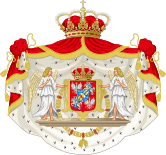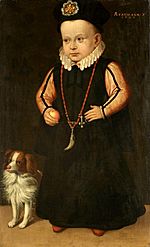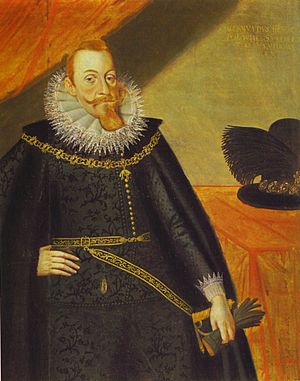Sigismund III Vasa facts for kids
Quick facts for kids Sigismund III Vasa |
|
|---|---|
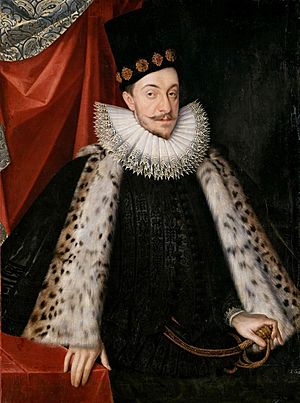
Painting by Marcin Kober, ca. 1590
|
|
| King of Poland and Grand Duke of Lithuania | |
| Reign | 18 September 1587 – 19 April 1632 (44 years, 214 days) |
| Coronation | 27 December 1587 |
| Predecessor | Anna Jagiellon and Stephen Báthory |
| Successor | Władysław IV |
| King of Sweden | |
| Reign | 17 November 1592 – 24 July 1599 (6 years, 249 days) |
| Coronation | 19 February 1594 |
| Predecessor | John III |
| Successor | Charles IX |
| Born | 20 June 1566 Gripsholm Castle, Sweden |
| Died | 30 April 1632 (aged 65) Warsaw, Poland |
| Burial | 4 February 1633 Wawel Cathedral, Kraków, Poland |
| Spouse | Anna of Austria Constance of Austria |
| Issue among others... |
Władysław IV John II Casimir John Albert Vasa Charles Ferdinand, Duke of Opole Alexander Charles Vasa |
| House | House of Vasa |
| Father | John III of Sweden |
| Mother | Catherine Jagellonica |
| Signature |  |
Sigismund III Vasa (born June 20, 1566 – died April 30, 1632) was a very important king in European history. He ruled as the King of Poland and Grand Duke of Lithuania from 1587 to 1632. This area was known as the Polish-Lithuanian Commonwealth. He was also the King of Sweden from 1592 until 1599.
Sigismund was the son of John III of Sweden and Catherine Jagellonica of Poland. He was chosen to be the king of the Polish-Lithuanian Commonwealth. He hoped to unite the Commonwealth and Sweden under one ruler, which he did for a short time in 1592. However, his uncle, Charles IX of Sweden, removed him from the Swedish throne in 1599. Sigismund spent many years trying to get his Swedish crown back.
Sigismund's long rule in Poland was a time when the Polish-Lithuanian Commonwealth was very powerful and important. But some problems that led to its later decline also started during his reign. Historians still debate whether these problems were because of Sigismund's choices or larger historical events.
A famous monument in Warsaw, called Zygmunt's Column, was built by his son and successor, Władysław IV, to honor him.
Contents
Royal Titles: What He Was Called
- In Latin, his full title was: Sigismundus Tertius Dei gratia rex Poloniæ, magnus dux Lithuaniæ, Russiæ, Prussiæ, Masoviæ, Samogitiæ, Livoniæque, necnon Suecorum, Gothorum Vandalorumque hæreditarius rex.
- This means: Sigismund III, by the grace of God, king of Poland, grand duke of Lithuania, Ruthenia, Prussia, Masovia, Samogitia, Livonia, and also hereditary king of the Swedes, Goths and Vandals.
Sigismund became King of Poland by election in 1587. He also inherited the Swedish throne in 1592 from his father. However, he was removed as King of Sweden in 1604. From his grandmother, Bona Sforza, he also held the title of King of Jerusalem.
Biography: His Life Story
Sigismund was born in Gripsholm, Sweden, in 1566. At the time, his parents were being held prisoner by King Eric XIV. Even though Sweden had become a Protestant country, Sigismund remained a Catholic, like his mother. This difference in religion caused problems for him later, especially in Sweden.
His mother, Katarzyna Jagiellonka, was the daughter of Sigismund I the Old and Bona Sforza. Her family, the Jagiellon dynasty, had ruled the Polish-Lithuanian Commonwealth since 1386.
In 1587, after the death of the previous Polish king, Stefan Batory, Sigismund was a candidate to become the new ruler of the Polish-Lithuanian Commonwealth. He was supported by important people like Jan Zamoyski and the former king's wife, Anna Jagiellon. On August 19, 1587, Sigismund was elected King of the Polish-Lithuanian Commonwealth.
However, another candidate, Maximilian III of Austria, also claimed the throne. Maximilian's supporters did not accept Sigismund's election. Sigismund quickly traveled from Sweden to Poland. He arrived in Oliwa on October 7. Before becoming king, Sigismund agreed to the Pacta conventa. This agreement reduced the king's power and gave more power to the Commonwealth's parliament, called the Sejm. Many historians believe this was the start of the Commonwealth's decline.
Sigismund was crowned king in Kraków on December 27, 1587.
Maximilian tried to take the throne by force, starting the War of Polish Succession. But Sigismund's supporters, led by Jan Zamojski, defeated Maximilian's forces at the battle of Byczyna. Maximilian was captured and later released after the Pope helped. In 1589, Maximilian gave up his claim to the Polish crown.
In 1592, Sigismund married Anna of Austria. Later that year, his father died, and Sigismund became King of Sweden. He promised to respect Sweden's Protestant religion. For a short time, the Commonwealth and Sweden were united under one ruler. Sigismund tried to rule Sweden from Poland, leaving his uncle, Duke Charles, in charge as a regent.
In 1596, Sigismund helped create the Union of Brest. This agreement tried to bring parts of the Orthodox religion closer to Catholicism. In the same year, he moved Poland's capital from Kraków to Warsaw.
After his wife Anna died in 1598, Sigismund married her sister, Constance of Austria, in 1605. At the same time, problems were growing on the Commonwealth's southern border. Polish forces lost a battle in 1620, and the Commonwealth had to give up its claims to the Principality of Moldavia.
Sigismund strongly supported the Counter-Reformation, which was a movement to strengthen the Catholic Church. This made him unpopular in largely Protestant Sweden. His uncle Charles took full control of Sweden and rebelled against Sigismund. Charles claimed that Sigismund wanted to make Sweden Catholic again. In 1598, Sigismund's army was defeated at the Battle of Stångebro. Sigismund was told he could not rule Sweden from Poland. He returned to Poland, and in 1599, he was removed from the Swedish throne.
This event, along with his decision to add Livonia to the Commonwealth, led to the Polish-Swedish War. This war lasted, with some breaks, until 1629. Sweden gained Livonia at the end of the war. Sigismund never gave up his claim to the Swedish throne. His foreign policy was often focused on getting it back. This led to many conflicts between Poland and Sweden.
In 1605, Sigismund tried to make the king's power stronger. He asked the Sejm (parliament) to limit the liberum veto (a rule that allowed any member to block a law). He also wanted to raise taxes and make the army bigger. His opponents, led by Mikołaj Zebrzydowski, started a rebellion called rokosz Zebrzydowskiego (Zebrzydowski's Rebellion). Royal forces defeated the rebels in 1607. However, the result was that things went back to how they were before 1605.
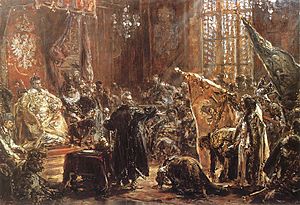
Another important conflict during his rule was the Polish-Muscovite War (1605-1618). Sigismund and many Polish nobles tried to take advantage of a civil war in Russia, known as the Time of Troubles. After a long war, the 1618 Truce of Deulino gave some land to the Commonwealth. However, this war increased tensions between Poland and Russia.
Sigismund was also a talented artist. He was a painter and a goldsmith. One of his paintings was mistakenly thought to be by the famous artist Tintoretto for many years. He also helped create the famous silver coffin of St. Adalbert of Prague in the Cathedral in Gniezno.
Sigismund died at the age of 65 in the Royal Castle in Warsaw.
Sigismund's Goals and Challenges
Many historians believe that Sigismund saw Poland as a way to get back the Swedish throne. To do this, he tried to make his royal power stronger. He also allied himself with the Habsburg family and the Catholic Counter-Reformation movement. Many Polish nobles, especially Jan Zamojski, opposed his plans. This led to the rebellion known as rokosz of Zebrzydowski (1606–1608).
Even though Sigismund never got the Swedish throne back, his desire to do so caused many wars between the Commonwealth and Sweden and Muscovy. The Commonwealth's parliament often stopped his plans. However, the Vasa family, including Sigismund and his son, did get the Commonwealth involved in the Thirty Years' War. The wars with Sweden, the Ottoman Empire, and Muscovy eventually led to a difficult period in Polish history called The Deluge. This period ended the "Golden Age" of the Commonwealth.
During his reign, he allowed the Hohenzollern family from Brandenburg to inherit Ducal Prussia.
Other Interesting Facts
Sigismund III Vasa is featured in a famous painting by Jan Matejko. The painting shows Piotr Skarga giving a sermon.
Images for kids
-
John III, his wife Catherine Jagiellon and young Sigismund imprisoned at Gripsholm. An 1859 painting by Józef Simmler.
-
Chancellor Jan Zamoyski strongly opposed alliances with the Habsburgs.
-
Archduke Ernest of Austria, whose letters with Sigismund caused a political problem.
-
Charles of Sweden, Sigismund's uncle, who fought against Sigismund for the Swedish crown.
-
Equestrian portrait of King Sigismund by Peter Paul Rubens
-
Sigismund as supreme commander of Poland–Lithuania, dressed in hose.
-
Victorious Sigismund at Smolensk, by Italian-born artist Tommaso Dolabella, 1611.
-
Apotheosis of Sigismund after his victory over the Ottoman Empire, an etching from 1629. The king's spear hitting a Turk shows the triumph of Catholicism and Christianity over Islam.
-
Gustavus Adolphus of Sweden in a Polish costume, 1631–1632. He was an enemy of Sigismund and tried to take Ducal Prussia and Livonia.
-
John Albert became a bishop at age nine and a cardinal at age twenty because of his father's fame.
-
Sigismund's Column (1644) in Warsaw reminds us of the king's decision to move Poland's capital.
-
Alchemist Sendivogius and Sigismund III, by Jan Matejko.
-
Anne of Habsburg was Sigismund's first wife. She was quiet and known for her dislike of Sweden and Protestantism.
-
False Dmitriy I promises loyalty to Sigismund III, by Nikolai Nevrev (1874).
-
Facade relief on the Golden House in Gdańsk.
See also
 In Spanish: Segismundo III Vasa para niños
In Spanish: Segismundo III Vasa para niños


